Camping often means you are hours away from the nearest hospital. You are also more likely to get sprains, knife or ax wounds, burns, and hypothermia when outdoors. Even a minor ailment like getting sick can leave you dangerously dehydrated if you aren’t prepared. For these reasons, I take my camping first aid kit very seriously.
Most first aid kits are not designed for camping and often have critical items missing. For example, you won’t find electrolyte packets for dehydration or moleskin for blisters in most first aid kits. The first aid kits chosen here are specifically made for camping and outdoors and are more complete.
Not sure how to use items in a first aid kit?
You need my Printable Camping Cheat Sheets
The guide contains 42 pages of illustrated information, including wilderness first aid, campfire cooking, tarp shelters, and more.
Best First Aid Kits for Camping
*Want to see how these camping first aid kits compare? This table has a list of what’s included in each kit.
1. Adventure Medical Kits Mountain Mountaineer Medical Kit
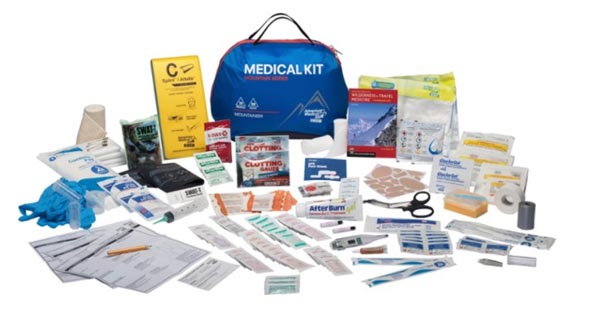
Adventure Medical Kits makes really high-quality, complete (emphasis on complete!) first aid kits for camping, backpacking, and outdoor sports. Their kits contain items you won’t find in virtually any other kit, like QuikClot, tourniquets, and C-splints. The products are also high-quality and reliable.
This kit is more geared towards mountaineering groups. However, it would also work well as a camping first aid kit to keep in your car.
Compared to the other camping first aid kits reviewed here, the Mountaineering kit contains many more items. This includes high-end items like:
- SWAT tourniquet
- C-splint
- QuikClot hemostatic pads
- Digital thermometer
- Sterile dressings
- Temporary tooth filling
It also includes everyday items you might need, like antihistamines, antacids, pain killers, flu medicine, and electrolytes. You could buy these yourself, but it’s nice they are already included. There are a few items missing (like probiotics, activated charcoal, and a Mylar blanket), but no first aid kit is ever perfect.
The first aid kit is a bit pricy. However, it actually does come out to be a good deal if you calculate the cost of each item individually. Just the tourniquet would cost you around $15. The two QuikClot bandages would be another $20….
I also really like the way the bag is organized. When you unzip the kit, there are several pockets which can be folded out. Each pocket contains items for a specific type of injury or ailment.
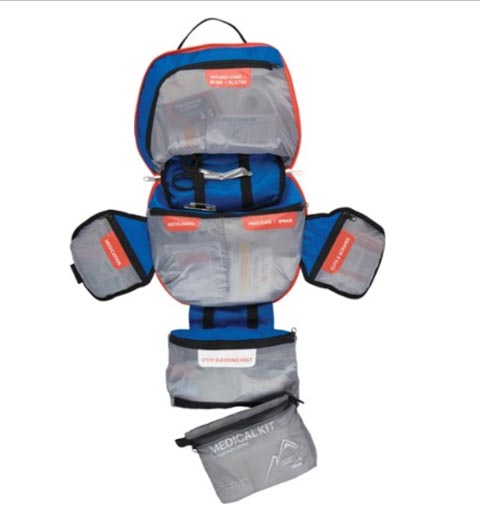
There’s also a mini detachable first aid kit. This is great for keeping your hiking first aid items. Just grab the mini kit when you go on a day trip.
Quick Info:
- Piece Count: 218
- Size: 10.5″ x 6.5″ x 7.5″
- Weight: 3.1lbs
- Buy here on Amazon
2. Adventure Medical Kits Sportsman Series 400 First Aid Kit
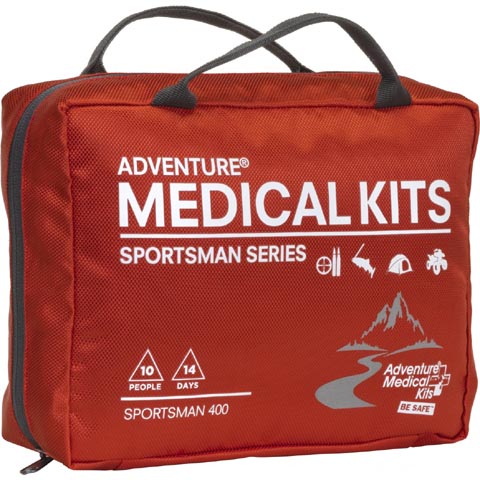
Also made by Adventure Medical Kits, the Sportsman Series 400 first aid kit is more affordable than the Mountaineer kit above. It doesn’t have as many pain meds. Nor are there any electrolytes, antacids, antihistamines, or some other meds. However, the kit still contains everything you’d need for dealing with minor and major ailments while camping – including high-end items like a SWAT tourniquet, C-splint, and hemostatic dressings.
The bag itself is also great; there are plenty of pockets for keeping items organized. A mini trauma kit can be removed and taken with you on hikes or day trips. I still like the Mountaineer kit better, but that’s my personal preference and this kit costs roughly $75 less.
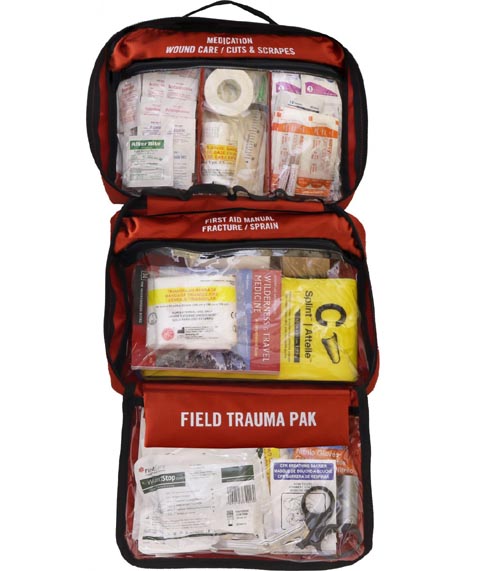
Quick Info:
- Size: 11″ x 8″ x 3″
- Weight: 2.5lbs
- Buy it here on Amazon
3. Advanced MyMedic MyFAK First Aid Kit
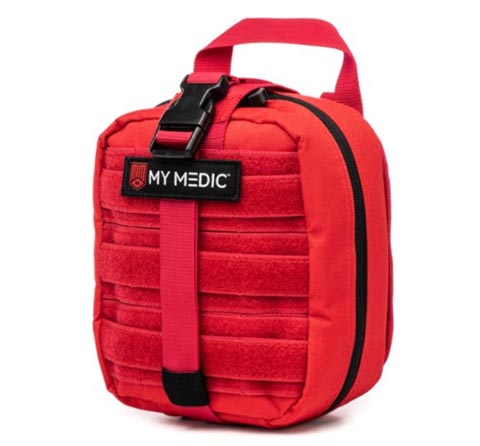
For a small pouch, this first aid kit has a surprising amount of items meant to save your life in really crappy scenarios. Admittedly, some of these items are going to be completely pointless unless you’ve had advanced medical training.
For example, there are suturing supplies in the kit. I personally would never stitch up someone’s wound – I’d get some butterfly closures on it and head to the hospital. Likewise, I wouldn’t know what to do with the Hyfin Vent chest seal.
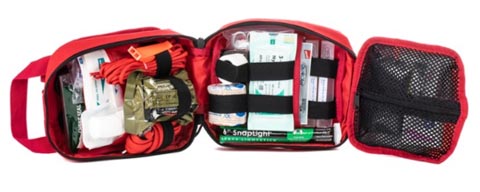
Thus, I only recommend this first aid kit for medical professionals. If this applies to you, then you’ll appreciate the kit is well-organized and can be attached to the back of a vehicle headrest.
Quick Info:
- Piece Count: 101
- Size: 7.75 x 6.75 x 4 inches
- Weight: 3lbs 3oz
- Buy it here at Amazon
4. Surviveware Large First Aid Kit
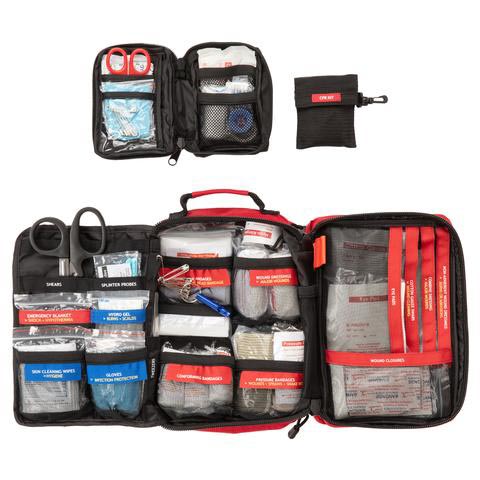
The Surviveware first aid kit comes in a MOLLE pouch which can also be attached to the back of a vehicle’s headrest. I like that there is a mini first aid kit within the pouch; take this smaller kit with you when you go hiking or on day trips.
The first aid kit contains 200 items plus another 50 pieces in the mini kit. However, don’t get drawn in by the piece count. Most of these items are bandages, antiseptic wipes, and other cheap items. The kit is missing a lot of the higher-end items you need in a camping first aid kit. There’s no tourniquet, C-splint or Sam splint, hemostatic pads, or medications. You’ll need to add these on your own. Luckily, there’s still plenty of space in the bag for all of these must-have items.
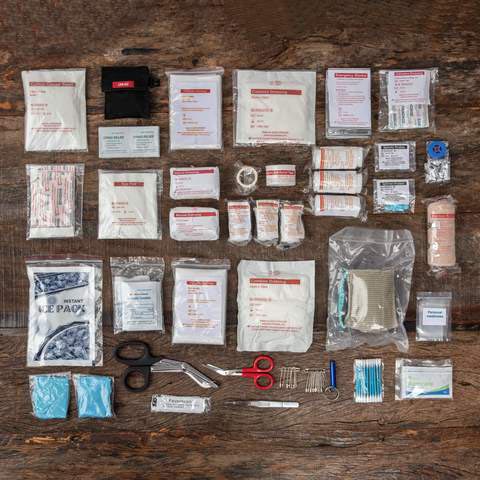
Even though the kit is missing a lot of essentials, it is still one of the best first aid kits out there. The bag has lots of organizing pockets, the items which are included are good quality, and the price isn’t too high.
Quick Info:
- Piece Count: 250
- Size: 12 x 8 x 6 inches
- Weight: 3.25lbs
- Buy it here on Amazon
5. DIY Camping First Aid Kit
While the first aid kits listed above are pretty damn good, none of them are complete. Whether it’s something small like tweezers or something major like a tourniquet, every first aid kit is missing something.
Instead of paying for one of these pre-made kits, you could instead build your own kit up from scratch. It usually ends up being a bit more pricy this way since you have to buy everything individually. You’ll still need a bag for organizing the first aid items. I like this one. But, if you already have a lot of first aid items at home, the DIY approach means you don’t waste money on duplicates.
Here is what I put in my camping first aid kit (printable list). I also have this lightweight version for hiking.
How to Choose a First Aid Kit for Camping
There are hundreds of camping first aid kits, and they range from a mere $15 to over $400. What’s the difference and which one do you really need? Here are some tips for helping you get the right first aid kit for outdoor adventures.
Organization Matters
If you just need a band-aid or moleskin for a blister, then it’s not a big deal how you organized your kit. But what if your spouse severs an artery while chopping wood for the campfire? You would need to find the QuikClot trauma pad and fast.
For this reason, it’s really important you keep your first aid items organized in a way which makes it easy to find them. Staying organized also makes it easier to see which first aid items need to be restocked.
Make sure the first aid kit you choose has lots of different pockets and compartments. Bonus if they have see-through windows!
Beware of Cheap First Aid Kits
I once made the mistake of buying a $20 first aid kit. It contained a lot of the items I needed, but the items were complete crap. The medical tape, for example, wouldn’t stick to my skin. It would peel off after a few minutes. The same applied to the band-aids in the kit. The only reason to get a cheap first aid kit IMO is for the bag. Then dump out the useless contents and fill it with your own.
Don’t Get Swayed by Piece Count
A 200-piece first aid kit for just $19??? Yes, there’s a reason it sounds too good to be true. Most of those pieces are probably cheap items (I actually saw one first aid kit which contained 20 tongue depressors and 50 cotton swabs towards its count!). For this reason, I haven’t listed the piece count of my picks for the best camping first aid kits.
Look for High-End Items in the Kit
Instead of focusing on piece count, pay attention to what high-end items are included in the first aid kit. This is where you will get the most value. Some examples of these items are:
- C-splint or Sam splint
- SWAT or CAT tourniquet
- QuikClot and other hemostatic dressings
- Butterfly bandages
- Trauma pads
- Tooth filling
Brand Names Matter
If you are just going to buy a cheap first aid kit for the pouch and then fill it with your own items, then brand name doesn’t matter much. However, if you want to get a complete kit, choose a reputable brand name. You are relying on these supplies to save your life! You don’t want to have the tourniquet break because it was a cheap knockoff (yes, this actually happens) or have medical tape unstick.
Choose a Red First Aid Kit
Get a red bag. It might seem inconsequential, but it really helps to have a red first aid kit bag. Red is the international color for first aid. If you get injured and someone else needs to grab your first aid kit, they will be more likely to find it quickly if it’s red.
Look for Detachable Mini Kits
The first aid kits listed here are pretty damn complete. That means they are fairly bulky and heavy. While this is fine for car camping, the kits will be too large to take on day hikes or backpacking trips.
The top first aid brands realize this is an issue so include detachable mini pouches in the kits. The pouch contains the most essential items you might need while on a day trip. Seriously – don’t forget a first aid kit even for “just a short hike.” You never know when you will succumb to a serious fall, break a bone, or worse.
Learn First Aid!
It’s pointless to carry around a complete first aid kit if you don’t know how to use the items in it. I highly suggest you take a wilderness first aid kit and learn life-saving skills like how to stop bleeding, how to splint a broken bone, and how to treat burns.
If you can’t take a class, then at least read this book about wilderness first aid. It pays to be prepared!
Did you get a pre-made first aid kit or build your own? Let us know in the comments section below.


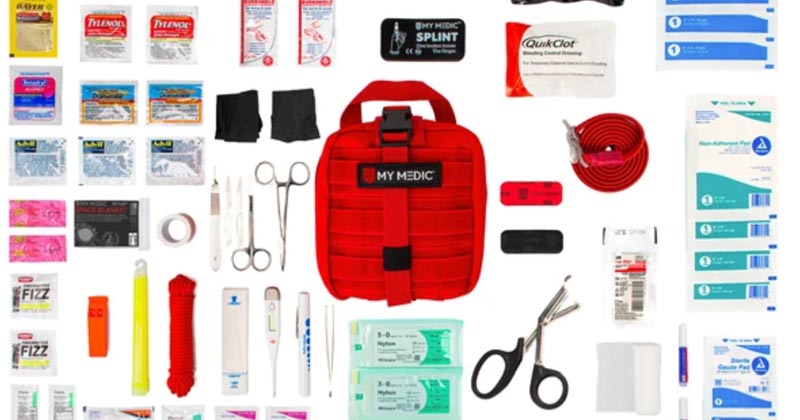
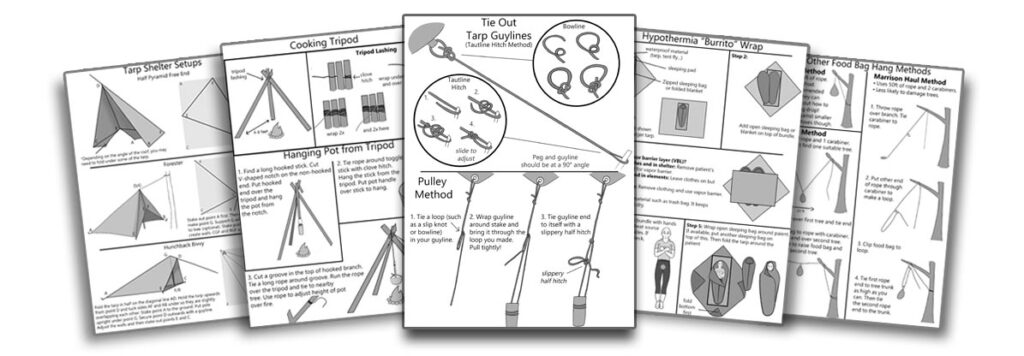
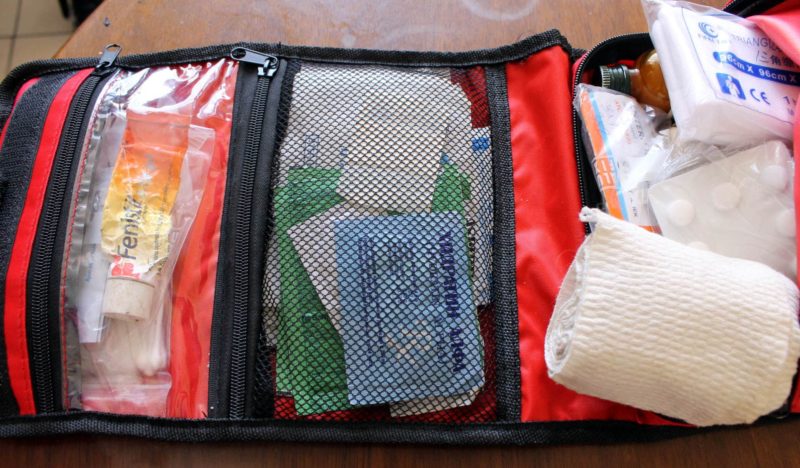
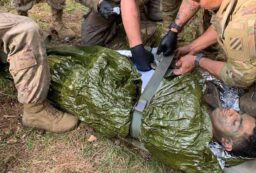
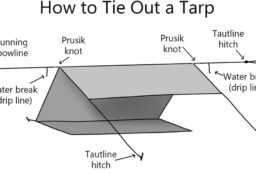
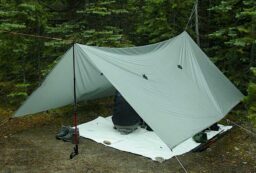







Post your comments